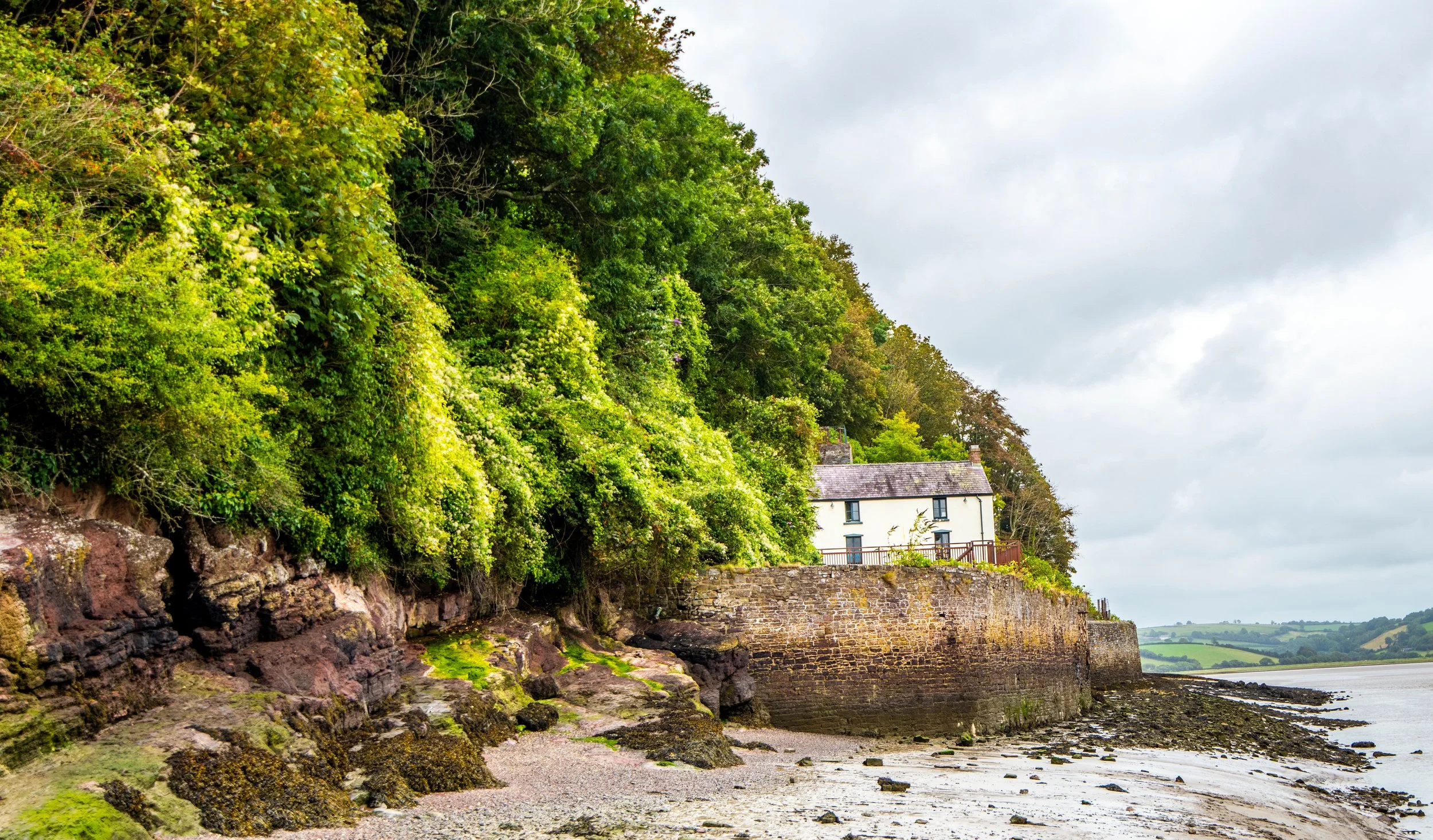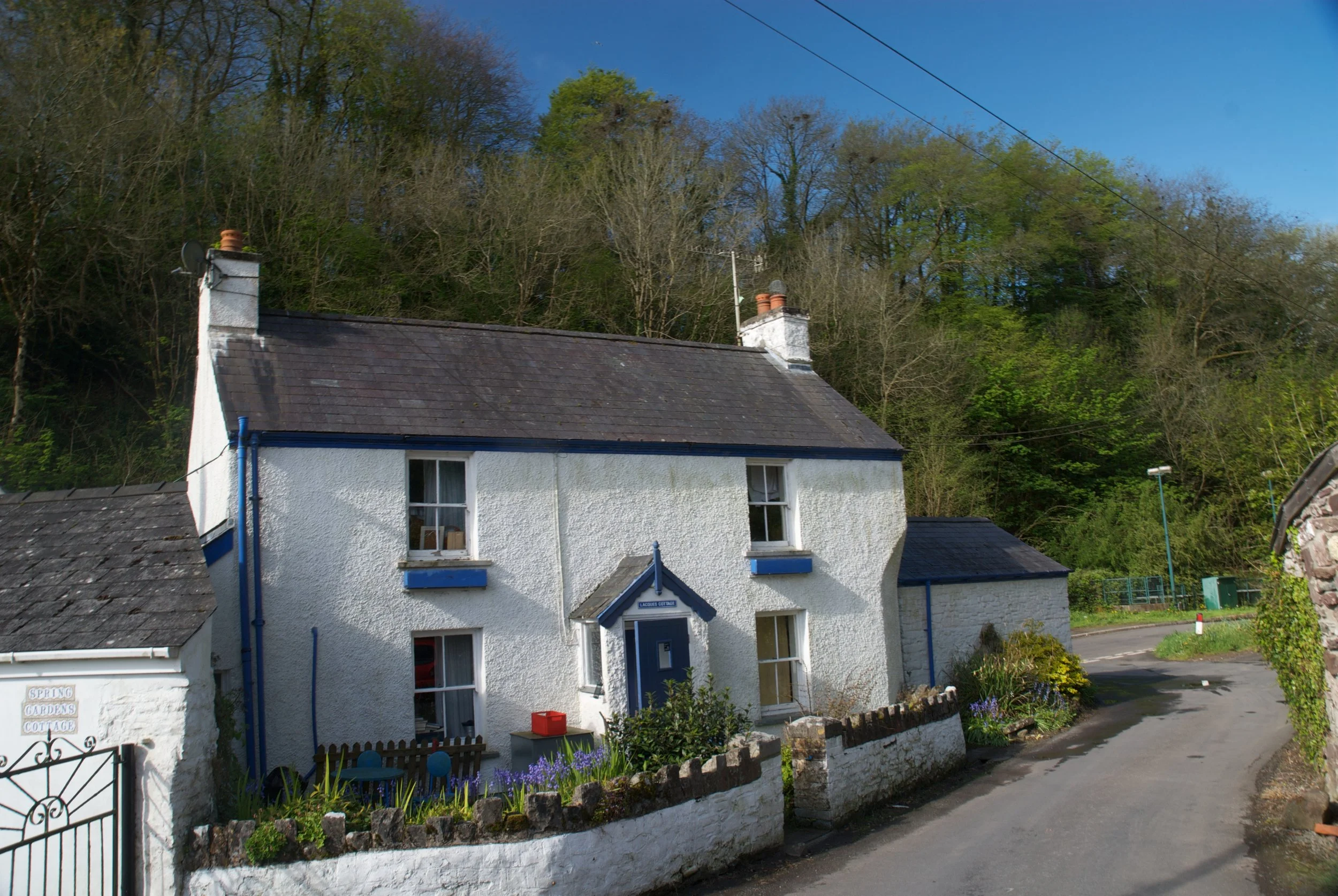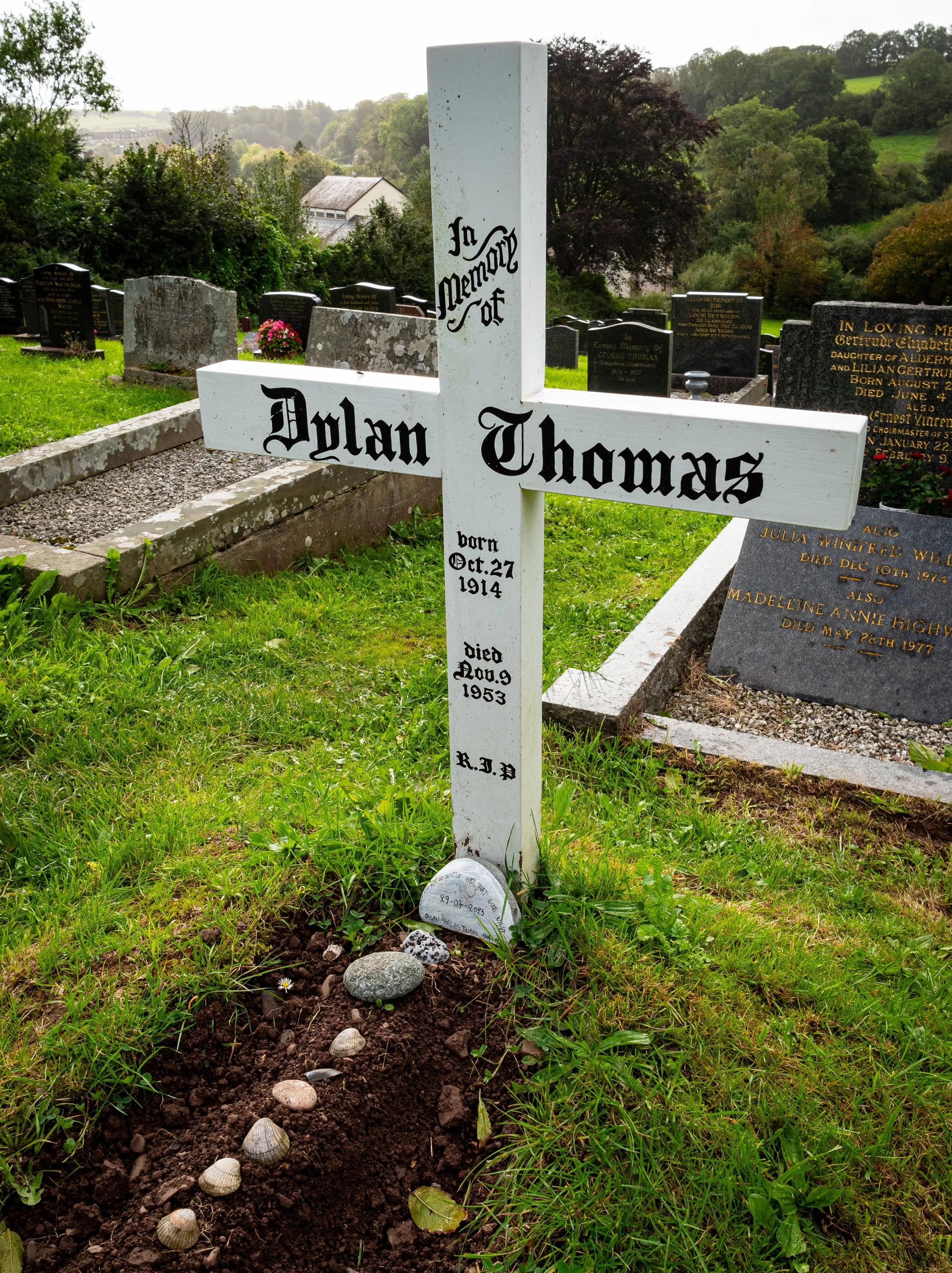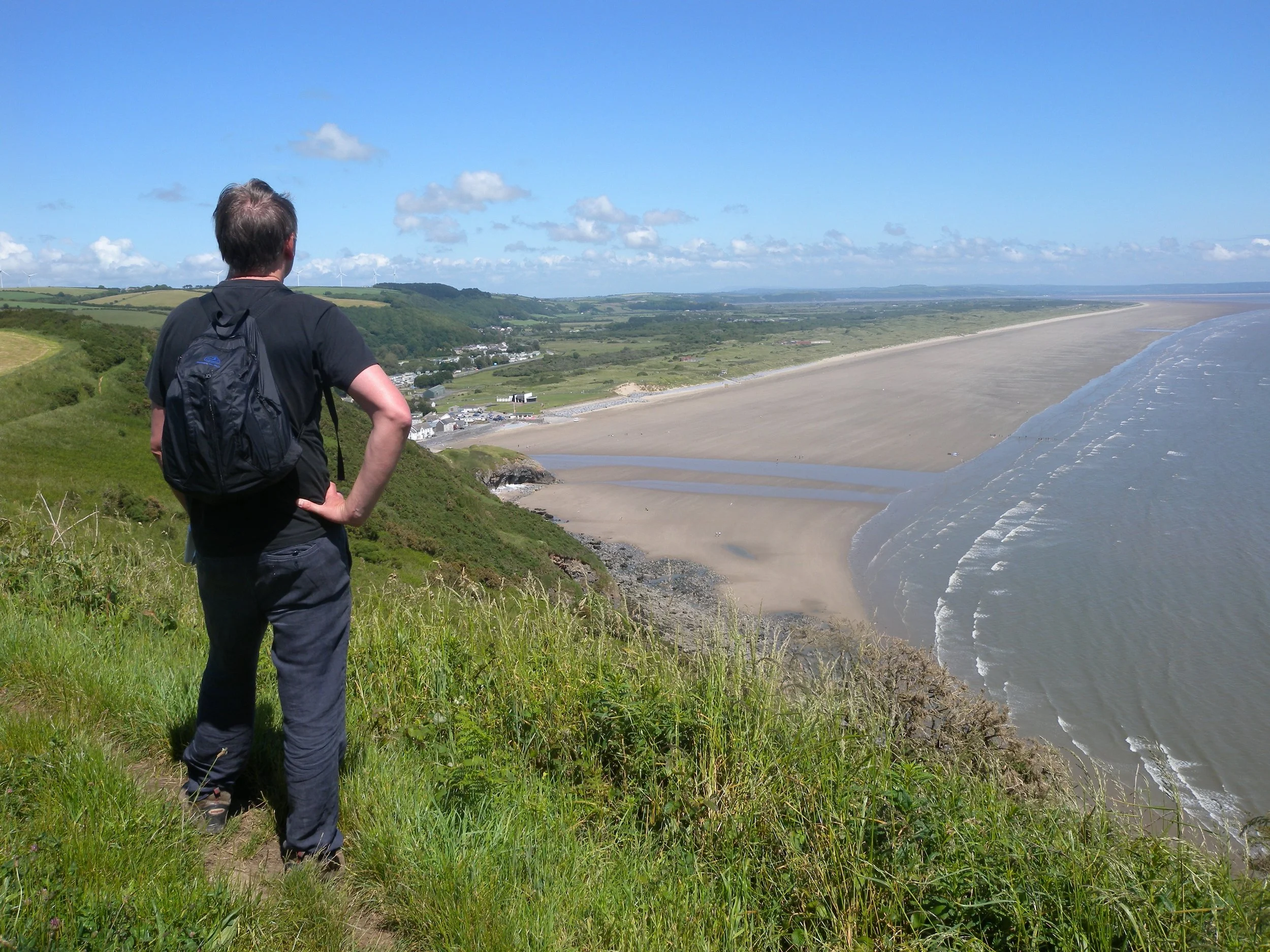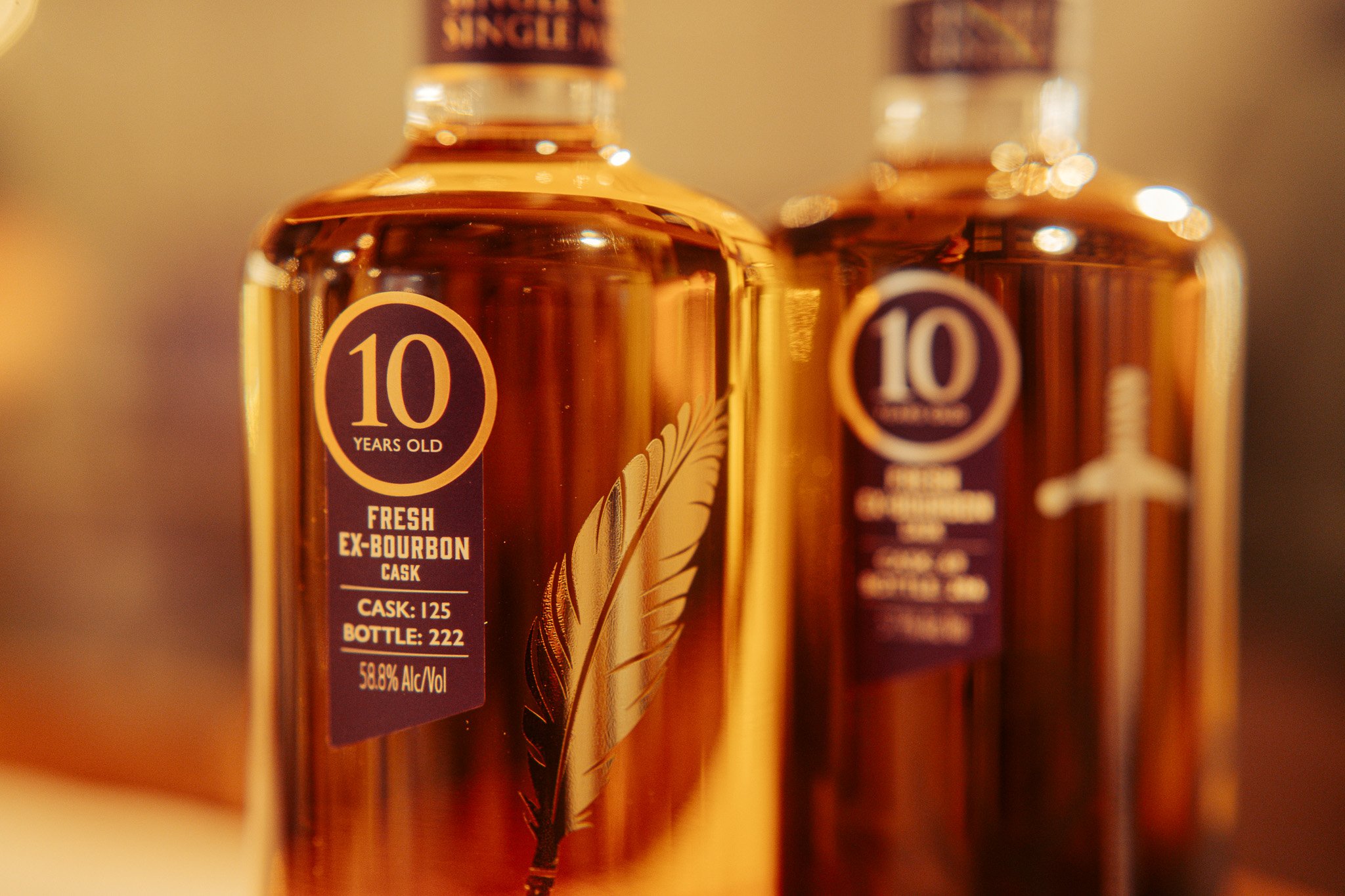Libations in Laugharne on the trail of Dylan Thomas
The Boathouse, where Dylan Thomas and his family lived from 1949 until his death in 1953
Drink, poetry and solitude. Chris Moss toasts the Welsh writer on a walk around the author’s favourite home town – and final resting place
Laugharne on a summer’s day looks like a poem. I remember a visitor from London saying they had location envy. It was a spectacular morning, with a pellucid sea, electric-blue sky, and a handful of writers, actors and travellers had gathered for a worthy literary event on the terrace of The Boathouse, Dylan Thomas’s former home – now a small museum. The township was thronging with people who had come for Laugharne Weekend, the annual literary and arts festival. And I had just moved there. I had won. I had drawn the long straw. Everything was perfectly poetic.
The spectacular view across the estuary from above The Boathouse
Of course, I was forgetting the real meaning of art. What drew Thomas, the Welsh poet and carouser to Laugharne was the beauty but also the strangeness and the intensity of the place. Nature is out of joint there. Seabirds live in the fields and corvids out on the estuary. The river Taf is more treacherous when the water is low. The town centre routinely floods and no one makes a fuss. Roads start strollable and then turn into hills that go on and on.
Caithness and Flow Country: into the wilds of northern Scotland
Everyone with a passing interest in Wales or literature knows about Dylan Thomas’s association with Laugharne, the township he called a “legendary lazy little black magical bedlam by the sea.” They know about his writing shed with its vista over the “heron priested” shores of the Taf estuary. And about his drinking, his dark moods, his death in America – he is buried at the main church here in the overspill graveyard beneath a plain white PVC cross. His ghost lingers, and his admirers come to smell the musty living room in The Boathouse where he lived and to look for characters from Under Milk Wood.
But Laugharne is not Stratford-upon-Avon, nor is it Haworth or Chawton, with their ties to the Brontë’s and Jane Austen. This small, steep-sided, village-sized town has retained the curious character – and, perhaps, some of the characters – that beguiled the Swansea-born bard ninety years ago. To discover how it might have done this, you have only to take a walk. In my case this meant leaving the cottage and turning right up Newbridge Road towards the pub, not for a drink, not yet, but in search of a different kind of oblivion.
‘Dylan Thomas’s ghost lingers; he is buried at the main church here in the overspill graveyard beneath a plain white PVC cross’
Laugharne came to me in instalments. In the late 1980s, Bob, a Cardiff-born university friend, was reading the newly published biography of Caitlin Thomas, Dylan’s wife (then still alive) and he mentioned to me a boozy little town he’d once visited. He talked fondly of Brown’s Hotel and Buckley’s ales. Decades later, as books and travel editor of a London magazine, I paid a visit. Bob came along. I found the town pretty, its people gritty; the pub was heaving, not with bookish types but with farmers, builders, shop assistants.
Lacques Cottage, the home Chris Moss rented after a “mad, whimsical half-dream”
I was enchanted and saw a little house, Lacques Cottage, for sale. I went back to London pondering, but non-committal. But when I finally escaped the capital I dived into the mad, whimsical half-dream and rented the house. On my first weekend London followed me on the train for the Laugharne Weekend, a mainly bookish, quiet punk-arts and music festival. Then everyone left and I got to settle in.
On the slow walk up Newbridge Road I pass a fairytale garden full of giant rhubarb and ferns and other lovers of the dark and damp, and then you cross a river. I have a small partly culverted stream of my own, but here at the bridge the water flows fast and bright. South Carmarthenshire’s rains and streams and rivers gather in the cow-filled fields and come down here looking for the sea. In the babble of the river is a clue to the place, for Laugharne is buried away from everywhere else, in a kind of valley with only one side.
Laugharne's Anglo-Norman fortress: there was as a city here once, but a 1607 flood wiped it away
At the junction with King Street you pan a half circle to take in terraces of not quite grand, pastel-painted faux Georgian houses, a post-office that doubles as a chemist’s, a secondhand bookshop, a potter’s and a knackered old petrol pump, and a road that slopes gently down to the entrance to the castle.
In ruins but still the loftiest thing around here, this Anglo-Norman fortress is evidence of the Laugharne’s strategic importance as a sea defence. There was a city here once, but in 1607 floods – possibly the result of a tsunami – wiped out most of the population. It hasn’t looked forward since.
There are other ghost buildings: a butcher’s, with its marble-walled windows; a now closed pub called The Pelican; a huge pile of a house with an empty ballroom at the rear. Many houses on King Street have spaces that used to be ballrooms. An old-timer tells me there were once 33 pubs. It’s a prodigious, mythic-sounding number, evocative of a grand and thriving past life – and a reminder of the present-day stillness of small towns.
Thomas called Laugharne that “legendary lazy little black magical bedlam by the sea”
Two key buildings are right here at the corner: Brown’s Hotel, Dylan Thomas’s favourite boozer, reopened this year as a small, smart hotel with a bar and a little library. Opposite is a proper pub: The Three Mariners, where the poet would drink if he were still around.
Writers like Laugharne. Proto-feminist Mary Wollstonecraft spent time on the nearby family farm in the late 18th century. Edward Thomas spent a few weeks of winter 1911 in the town and in The Happy Go-Lucky Morgans (1913) contrasted grimy Balham in London with an idealised version of Laugharne. Richard Hughes, who wrote High Wind in Jamaica (1929), lived at Castle House from 1934-36 and was the town’s petty constable (there are lots of such honorary posts here, all of them equally petty). In the 1980s, Kingsley Amis spent time at Cliff House and is said to have written parts of his Booker Prize-winning 1986 novel The Old Devils here.
Brown’s Hotel, Dylan Thomas’s favourite boozer, reopened this year as a small, smart hotel with a bar and a little library
These authors came for the tranquillity and the time and space to think, for the disconnection from London and from the so-called literary life.
Laugharne has not been overly prettified. Yes, the cottages on Victoria Street, which I pass as I leave the Mariners behind me, are pastel-hued, but each is adorned with a satellite dish. There’s no beach, no deli, no farmer’s market, no museums of local life, no galleries selling blue-tinted watercolours. Ten minutes’ drive away is Pendine Sands: static caravan sites, “family fun” and Mr Whippy.
‘Authors came for the tranquillity and the time and space to think, for the disconnection from London and from the so-called literary life’
Following the curve of Market Lane, I pass some pretty little houses and then come down a sloping path to the sea. Cliffs encircle the wide Taf estuary, where curlews whistle. To walk only once along the edge of the water is to miss the point of the place. Estuarial life is about shifting moods and reading the seasons and the weather through the oscillating tides.
Inside Dylan Thomas’s writing shed: his wife Caitlin would lock him in so he didn’t escape to the pub
Except at highest water, a path follows the foot of the red sandstone cliffs to two steep staircases that lead up to a narrow road. Here is Dylan Thomas’s writing shed, once a garage built to house Laugharne’s first car (a green Wolseley). “My study, atelier, or bard’s brothy, roasts on a cliff-top,” wrote Thomas to a friend. But in winter it must have been a damp den of an office and it’s unlikely the little coal-fired stove that can still be seen on one side did much to defrost the poet’s fingertips. Caitlin would lock her husband in the shed to “help” him meet his deadlines – and keep him from slipping off to Brown’s.
“My study, atelier, or bard’s brothy, roasts on a cliff-top.” Dylan Thomas’s writing shed
A few steps along is The Boathouse, the third, and final, house the Thomases occupied in Laugharne. Previously, they had spent periods at “Eros” on Gosport Street and at Sea View, now a hotel. The Boathouse, where they lived with their three children from May 1949 until Dylan Thomas’s death in November 1953, stands apart from the main town. It has some of the loveliest views of the estuary and beyond and is the most photographed spot in Laugharne. Inside are a parlour and bedrooms that have been refitted to exhibit photographs and furniture, a chaise longue and a desk, books and a death mask of Dylan made by American artist David Slivka, formerly the property of Richard Burton and Elizabeth Taylor.
‘The main town square is busy with boozers hopping from pub to pub, from conversation to quarrel, from sobriety to oblivion of the real, unpoetic kind’
Out on the terrace, away from the memorabilia and the booming voice of Dylan reading his verse, spare a thought for Caitlin. She left Laugharne for Italy in 1957, describing it as a “permanently festering wound.” This might not fit neatly with the stock hiraeth-filtered version of Dylan and Wales, but it remains the truth; the words came through drink and darkness and despair, and Laugharne and The Boathouse are part of that reality.
Dylan Thomas’s plain gravestone in the overspill cemetery in Laugharne
The best local walk is known as the Dylan Thomas Birthday Walk. It sweeps up around Sir John’s Hill south of the town to a high vantage point for remarkable views of the mouth of the estuary, an expanse of marshland riven by pills (drainage ditches), and, across the bay, Llansteffan and Pembrey Forest. In the haze is the Gower Peninsula, a low finger of land jutting out into the Bristol Channel and marking the limit of Carmarthen Bay. Afterwards you climb over the hill itself – clock the mobile masts, which don’t work for my phone – and stumble back downhill into town.
At the end of all walks there’s always the pub. Not content with being forgotten by the wider world, Laugharnians like to forget their working day, their women (and men!) and other woes by gathering at the Mariners, or the Cross House, or Brown’s, or the Fountain (aka the rugby club) to drink; at weekends, The Grist – the main town square – is busy with boozers hopping from pub to pub, from conversation to quarrel, from sobriety to oblivion of the real, unpoetic kind.
The author drinking in the view over Pendine Sands
Where city folk cluster in cliques and drinkers in big, broken towns arrange themselves in rival factions, in Laugharne, in the main, it’s an open house-free for all-everyone invited affair. My only rule is not ever to be the last in the bar; on Sunday mornings I always hear about breakdowns – in communication, of nerves, of marriages – and I don’t want to be there when they happen.
According to biographer Paul Ferris, Dylan Thomas told a friend that he drank to reconcile the disorder outside and the order within himself (Ferris says Dylan was drunk when he said this). When I head home after a last (third, perhaps fourth) glass of Penderyn at Brown’s, I go back down Newbridge Road. If I look up and it happens to be clear I feel reconciled to the stars above. If the cosmos is chaos, after all, then maybe Dylan was right.
‘Laugharne has not been overly prettified. There’s no beach, no deli, no farmer’s market, no museums of local life, no galleries selling blue-tinted watercolours’
A cockler once lived in my cottage. The shed where I store my books probably housed (everything is probably in local history), a horse or donkey, employed to freight the shells back from the treacherous mudflats. He would have risen before the sun on those days when the tides demanded and set out from the deep vale at the western end of Laugharne – Lacques is just about the last house before you leave town – and walked across The Grist and on to the great, lonely mystery of the estuary’s seaward edges. In that, as much as in any celebrity scribbler’s feted outpourings, there is a deep and honest poetry. Oblivion takes many forms. It can be the dreaded alcohol, it can merely be being forgotten, or it can be – and Thomas laced all his poems with this theme – death itself. Even in the dark you can hear the crows waking and that plaintive call.

